Some training ideas specific for alpine climbing
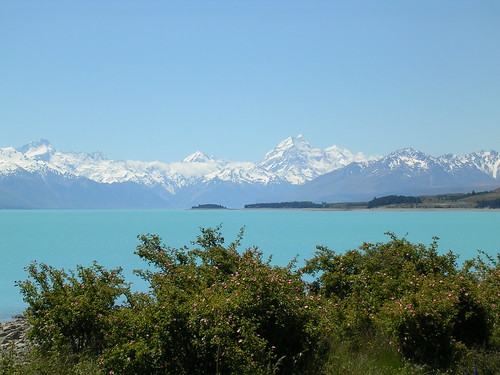
The mighty Southern Alps, New Zealand.
Prominent are (from left to right): Mt Sefton, The Footstool, Mt La Perouse, Aoraki - Mt Cook and Mt Tasman
Many people looking at getting into Alpine don�t quite know what to expect. This is especially true in Australia when our grandest peak has a 4 wheel drive track to the top. However there are �alpine� challenges in Australia and there are ways to prepare yourself for bigger trips. Most Australians will first go to New Zealand, usually in the summer season. The preceding winter offers many opportunities to develop skills whilst still in Australia that will give you a head start once you get to New Zealand.
Firstly what is involved in climbing a New Zealand? Well firstly there is usually a horrific walk over horrible moraine; followed by weaving your way through crevasses on a glacier. As the approaches are so long, usually a bivouac or a stay in a hut will follow. After that you can generally expect more glacier travel followed by either rock, ice snow or mixed climbing. Each of these media presents different challenges and, to a degree, you can train your skills on all of them right here in Australia.
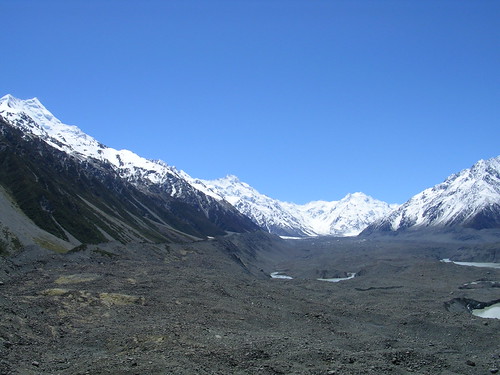
Approaches:
I wont tell you how to train, but I would advise doing some. In Australia we just don�t have the same height gains as in New Zealand. Emphasise hiking up hills, sometimes with a pack: hiking uphill is 90% of mountaineering. Most mountaineering texts say that 300m uphill an hour is a good pace. Try to aim for 500m and hour comfortably. Days gaining anything up to 2000m of altitude are not uncommon in New Zealand.
Crevasses;
You can learn crevasse rescue at any climbing wall or cliff. Self rescue skills from crag climbing will help here. Find a text, or if your unsure an instructor and learn how to haul. Learn how to prussic, with one cord only, with a variety of set-ups, and with a minimum of gear. You can even practise using snow stakes in the ground (good earth is as solid as any snow) but do it all with a bomber backup anchor. If your taking a course in New Zealand, it makes sense to learn crevasse rescue before you arrive, otherwise you�re wasting your $400 dollars a day sitting in crevasses when you could be climbing peaks. Obviously we don�t have Crevasses in Australia, but large snow banks and cornices can be found to practice at. (oh and don�t throw your buddy off, practice rescuing a weighted pack if your just learning this stuff) The Kosiouszko cornice can be good for this.
Bivouacing:
You can learn all the aspects of living in the cold in Australia. You really don't need much if you're sleeping in huts (the huts in NZ are much cosier than those in Oz) It is also worth learning how to bivouac. I don't like tenting as tent are heavy and they blow away in high winds. Always aim to minimize how much stuff you have to carry: if you sleep in all your clothes you can use a lighter sleeping bag. Down sleeping bags are lighter but it is false economy if it gets wet. Eating utensils can be light; learn to manage with one pot and a spoon each. Make up recipes which only require boiling water. Test out your clothing systems, and especially find a glove system that works. Two Items of clothing will greatly increase your comfort: a windshirt and a belay jacket. the windshirt (eg marmot driclime) can be worn in a huge range of conditions, minimising stop-start layering and a synthetic belay jacket can be thrown over whatever else your wearing once you stop, down will get wet if you try this with it. Get comfortable in the winter environment, NZ is a lot more hostile than Oz!
Alpine Rock:
Most people getting into mountaineering come from either a rock climbing or a hiking background. Those with skills gained crag climbing will find them useful in mountaineering. Those without such skills must learn them. Alpine is like the difference between sport and trad all over again. Be prepared to adjust a little once in New Zealand. The first thing you will realise is that NZ rock (with a few wonderful exceptions) is pretty bad. Learning how to climb loose rock safely can be done on �crap� climbs at home. Try to find long scrambles where you can practice moving confidently unroped on easy terrain. Go adventure climbing at places like the Warrumbungles, Mt Buffalo and Bungonia. Practising climbing in bad weather and at night are also incredibly valuable as you won't get so scared when confronted with these situations in the mountains.
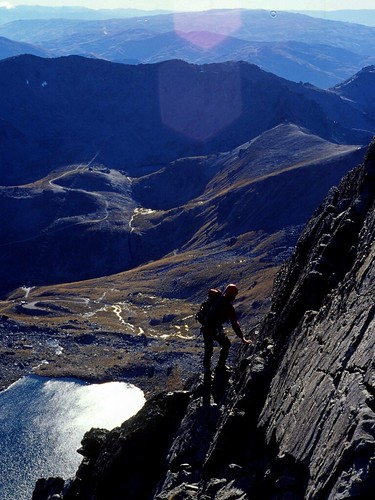
Alpine Rock Traverse in the Remarkables, New Zealand. Most of this was unroped scrambling at around Oz grade 6 - 12
Alpine Ice:
There are a few destinations in Australia where you can hone your ice climbing skills. I am planning on posting a guide to winter climbing in Australia in the near future. Online Guides to Mt Bogong and Mt Buller can be found at www.chockstone.org; Blue lake also has some Ice climbing possibilities.
Finding long slopes of easy ice where you can practice front pointing and leading will have more benifits for beginners than top roping 5m high bits of water ice. (although they are much more fun) Don�t expect to find too many good screw placements in Australia. Carry snow-stakes or (heaven forbid) sawn off snow-stakes!
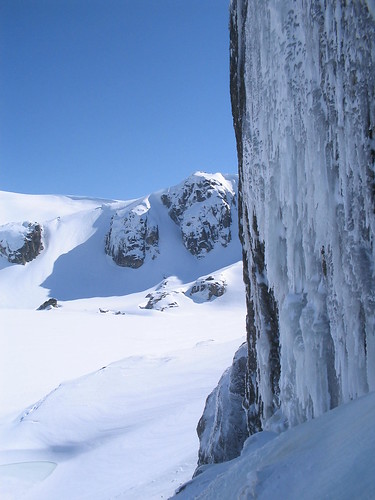
Blue Lake in Winter: The Ice conditions in this photo are a tad thin, unfortunately!
Alpine Snow:
Practicing cramponing (French technique) and self arrest in Australia makes obvious sense. Find a relatively steep slope, get some speed and learn to self arrest in every orientation (front/back, headfirst/feet-first) Practice without your crampons on. Several people have broken their legs after snagging crampon points while practicing. Learn how to hold your axe when walking and how to self belay with it. Learn American technique too, and all the other variations with their funny French names!
You can build snow anchors in Oz too! Learn how hard snow has to be to take a stake and when you need a dead-man instead. Build them, then test them, and try to pull them out; learn how much force they take, you don�t want to learn these things half way up a route in New Zealand.
Learning to ski can help speed up approaches in winter. In fact XC skiing in australia is probably the best way to get fit while also collecting experience spending time in the cold.
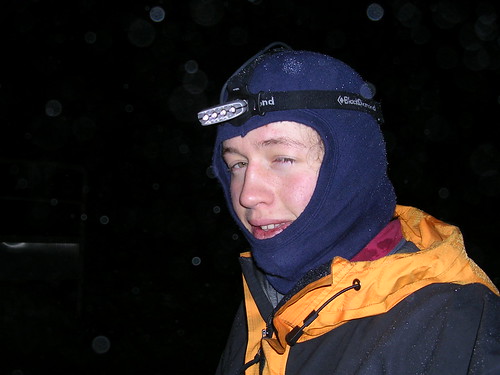
Here is a picture of one training trip XC skiing in the dark; we left canberra at 11pm (after a freinds going away party) got to the snow at 2am, skiied until about 5:30am, then tested out new bivy sacks till dawn, then skiied for another 5 hours or so. We left for home at midday and I got back for work that afternoon at 3:30pm!
Mixed Climbing:
Learning to confidently climb rock in crampons is a valuable skill. However: do not bring your axes/poons to the local crag or climbing wall. Do not damage the rock. You probably won�t be allowed in your climbing gym (ever again) if you try this.
Try to visit Buller or Bogong. Maybe you can find a brick wall to practise traversing on. If you visit the snow in the winter many of the chalets offer excellent technical dry-tooling possibilities on those lovely stone walls around the edge. Try not to get caught, and if you do, I didn�t endorse doing this!
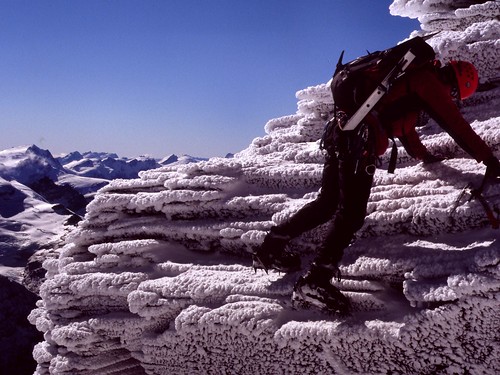
Climbing rock in Crampons, New Zealand
THIS ARTICLE IS NOT FINISHED: I HAVE LOTS MORE INFO TO GO IN HERE! SOON!


<< Home